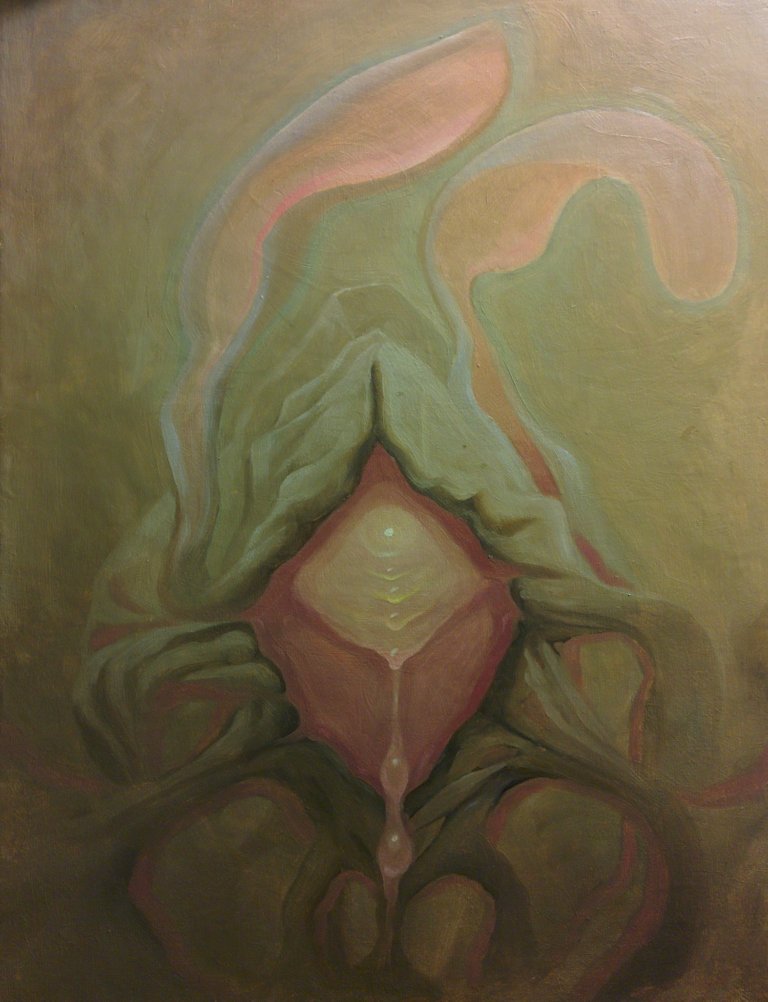Inner-Space Invader was one of those paintings which seemed in many ways to have its own agenda. In this case it seemed to pull in a narrative of a previous era of martian men and aliens with glass shells for skulls, and away from archetypes of classical psychedelia.
The result was that the painting metamorphosed a number of times and radically changed from its initial inception by the time it resolved.
In the beginning, the work began to form rabbit ears and consisted of a network of fibrous ligaments attached to its environment as seen below:

It's central "face" consisted of an iteration vertically and down from an illuminated cycloptic eye. This proved to be the least mutable feature throughought its construction. Right away the image took on an earthy kind of quality, aside its face. However, that changed very quickly:

As seen above, it quickly adapted a more aquatic nature. At this stage I remember thinking of it more in terms of a deep sea creature or nautilus of some kind. Many of its connecting filaments broke off and became mollusc-like; looking now more like a variety of breathing siphons or short sucker tubes. It's rabbit ears vanished, as one might expect from a magic rabbit, and the creature's brain grew crystal structures and a seminal transparent skull. Two long trailing tentacles instantiated as well. At this point I thought perhaps this would be an underwater scene.
Its central face began to develop more in detail:

As the face developed, so too did its brain and its transparent outer skull, which hardened and sharpened in detail. Additionally, as seen below, some form of miasma began to effuse from the tips of its tentacles, and a slight vibration began to occur beneath the creature's body. It's molusc-like "siphons" developed further, becoming more like primitive eyes, and reminding me somewhat abstractly of martini olives.

The miasma it was producing developed even further, to an emerging profusion of form and ectoplasm:

As we see above, a sudden increase of illumination occurred, from its crystal brain and clear skull, to the tips of its tentacles, which began to glow similar to its central eye. The effusion accumulated throughout its environment, becoming somewhat smoky at the base and more precipitous above. This effect continued like a chain reaction as we note below:

The smoke or fog at the bottom had now become a released steam from the body of the creature, and the nebulous protoplasm from its tentacles now became dynamic but overwhelming. In a snap, the scene changed to something more meditative as a balance:

The space returned, filled now only with some Japanese lanterns, as a moment of repose. This, however, would only be a quiet interval before the work found its final vector:

Astral crystals began to descend down from the air, catalyzing a vibrational effect over the skull. The fundamental composition at his point had been decided, and its refinement continued:

In the picture above we note that the ends of its tentacles lose their illumination and slime over with a substance which reminded me a lot of certain predatory plants. The sky crystals grew dynamic and varied. The details of the work continued until finally it's conclusion was reached and its name was determined. The final image and its full description are below:
"Inner-Space Invader", Oil on Canvas, 30 cm x 40 cm (approx. 12" x 16"), 2016

Description:
This vignette resulted in an entity with both an alien and familiar composition; at once exhibiting plant, animal, marine, mineral, and extraterrestrial qualities. Like a hermit crab its “brain” is encased in a shell. Its brain casing is transparent, revealing neurological folds and harder crystalline structures which compose its mind. The exposed face of the creature consists of an illuminated central eye, its “consciousness”, reflecting onto morphing layers of material which drip down the center. It has 4 short appendages with red lenses, most likely another form of eye.
The creature hovers while releasing steam. Two long appendages curl behind, terminating in pink gelatinous masses similar to what one might find in certain carnivorous plant species.
Against a smattering of stars in the background, the sharp reflections on its shell resemble a constellation, revealing a celestial origin.
Your drawings are really outstanding
Hope to see more of you on the network and also your recent artworks
Thanks Tormiwah, I will definitely try to post more as I am able to.